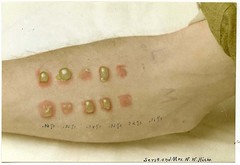Some helpful advice I found while searching for images in the Archives -
Jasmine High, MA
Archives Technician
Otis Historical Archives
National Museum of Health and Medicine
An unofficial blog about the National Museum of Health and Medicine (nee the Army Medical Museum) in Silver Spring, MD. Visit for news about the museum, new projects, musing on the history of medicine and neat pictures.
Some helpful advice I found while searching for images in the Archives -
Jasmine High, MA
Archives Technician
Otis Historical Archives
National Museum of Health and Medicine

Op-Ed Contributor
The Short Life of a Diagnosis
By SIMON BARON-COHEN
Published: November 10, 2009
http://www.nytimes.com/2009/11/10/opinion/10baron-cohen.html
Asperger syndrome and autism should be thoroughly tested before being lumped together in the Diagnostic and Statistical Manual of Mental Disorders.
Challenge coins have been proliferating in recent years, due to decreasing costs among other reasons.
Information can be found in this article -http://www.washingtonpost.com/wp-dyn/content/article/2009/11/01/AR2009110102261.html
We have an extremely large, but not well-catalogued, numismatics collection occupying a couple of safes in Historical Collections. To better position the Museum for the long-term addition of these to the numismatics collection, I’ve proposed that we scan the ones that people have on their desks, and record who was giving the coin out and when. I did the ones on my desk this morning




This turns out to be about the Kennedy Assassination.
The 1997 report I wrote that the article mentions is online here.
The original Finck report was scanned this past year and we put it online here.
We got a research inquiry today asking ‘what was ‘black tongue’ which threw me for a moment as I’d never heard of it. Fortunately my predecessors recorded information about it.
Black Tongue was a common name for erysipelas – see the two attached documents from the Medical & Surgical History of the War of the Rebellion (3rd Surgical vol.) in the footnote starting on the first page.
http://en.wikipedia.org/wiki/Erysipelas gives an overview and you can see why it would be a dangerous disease before antibiotics.

Halloween at the Medical Museum
![MCSO02952_0000[1]](cid:image004.png@01CA522C.FC3DD5F0) When: Saturday, October 31, 2009, 10:00 a.m. - 1:00 p.m.
When: Saturday, October 31, 2009, 10:00 a.m. - 1:00 p.m.
Where: The National Museum of Health and Medicine
Building 54
What: The National Museum of Health and Medicine and Family Magazine will host family-friendly Halloween activities for ages 5 and up. Children will be able to participate in a costume contest (with prizes!) and make skeleton crafts (a dancing macaroni skeleton, a medieval plague mask, and a skeleton wall hanging) as well as join in a Halloween-themed family yoga demonstration by Shakti Yoga.
Cost: FREE
Photo ID required.
For more information: nmhminfo@afip.osd.mil or (202) 782-2673
http://www.nmhm.washingtondc.museum
NEW TEMPORARY EXHIBITION OPENS ON HALLOWEEN:
Outbreak: Plagues That Changed History
On Exhibit October 31, 2009 – January 22, 2010
OUTBREAK is the story of epidemics that changed human society. Learn how diseases such as smallpox, cholera and yellow fever shaped our history, our culture and our civilization. Featuring the art of Bryn Barnard.